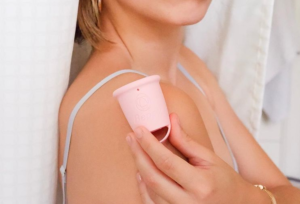2020 has been one of the most challenging years in our history and from which we have learned many things. One of these learnings has been the importance of staying healthy and comfortable. It’s normal, then, that we begin to wonder how we take care of our bodies and which are the healthiest alternatives to do so. In these cases, we may ask ourselves, are menstrual cups really healthy? With total certainty we can tell you: yes, and one of the best options nowadays!
On the one hand, the menstrual cup is made of medical grade silicone, which is hypoallergenic and does not represent a danger to our body when it comes into contact with the internal walls of the vagina. Likewise, this material does not degrade or oxidize and reduces the accumulation of bacteria, avoiding bad odors and more delicate conditions.
Although menstrual cups can be considered a safe menstrual product, it is important to be aware that T.S.S (Toxic Shock Syndrome) typically associated with the use of tampons, can also be developed when using menstrual cups. A study done by Nonfoux et al. (2018) indicates a growth of Staphylococcus aureus and TSST-1 production on menstrual cups after 8 hours (in-vitro). Even after 3 washes with water the biofilm of Staphylococcus aureus remained. Based on their study they state: “A protocol including a second cup that allows for cup sterilization by boiling between uses should be recommended”. If you want to read more about T.S.S and how Beppy helps you reduce the risk have a look at our blog post.
On the other hand, having become a popular alternative, the menstrual cup has been exposed to various studies by prestigious universities and research centers. These brought favorable results in the health field, becoming an excellent choice in feminine hygiene products. One of these studies entitled: Use, leakage, acceptability, safety and availability of the menstrual cup, carried out by the Liverpool School of Tropical Medicine, published the analyzes and results that promote the use of the menstrual cup worldwide, especially in developing countries and regions with sanitary difficulties.
It was also shown that the correct use of the menstrual cup together with good hygiene habits, decreased the occurrence of candidiasis and vaginal and urinary infections in the group of women who participated in the study. Hand in hand with this, it was found that there was an exponential decrease in skin and internal irritations, compared to those registered during and after the use of tampons and disposable menstrual pads.
Finally, the studies concluded that there was no increase in cases of endometriosis or negative effects that could affect sexual and reproductive health, indicating that the use of the menstrual cup is safe and beneficial when using it, both for users who have not still started their sexual life, as for women who have already had one or more pregnancies and have an active sexual life.
It’s very important that you remember that menstrual cups must maintain the same regulations as any feminine hygiene product which varies per country. Taking these factors into account, such as the quality and durability of the silicone, will ensure a good investment for both your finances and your health.
Sources:
- van Eijk, A. M. (2019, 16 julio). Menstrual cup use, leakage, acceptability, safety, and availability: a systematic review and meta-analysis. The Lancet Public Health. https://www.thelancet.com/journals/lanpub/article/PIIS2468-2667%2819%2930111-2/fulltext
- Nonfoux, L. et al (2018, June). Impact of currently marketed tampons and menstrual cups on Staphylococcus aureus growth and toxic shock syndrome toxin 1 production in vitro. Applied and Environmental Microbiology. https://pubmed.ncbi.nlm.nih.gov/29678918/









 Made for France
Made for France